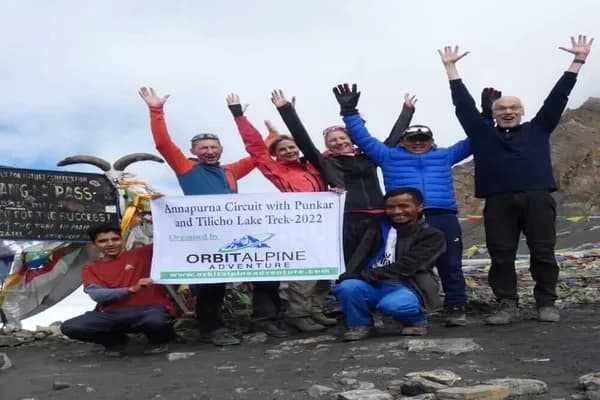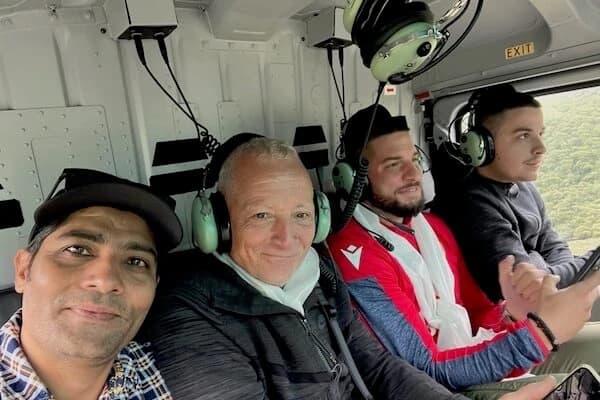Planning a trek in Nepal but not sure whether a short trek or a multi-day circuit is right for you? You are not alone. Many travelers face this choice when time, budget, and fitness levels all matter.
Short treks are perfect for beginners, families, and travelers with limited time who still want to enjoy the beauty of the Himalayas. Multi-day circuits are better for those who want adventure, high mountain passes, cultural experiences, and the challenge of longer journeys. Both options give unforgettable views and memories, but they suit different types of trekkers.
Picture yourself reaching Poon Hill in just a few days to watch the sunrise over Annapurna. Or imagine walking the Annapurna Circuit for weeks and crossing Thorong La Pass at 5,416 meters. Whether you want a quick Himalayan escape or a life-changing adventure, choosing the right trek makes your journey enjoyable and safe.
This guide will compare short trek vs multi-day circuit options in Nepal. By the end, you will know which trek matches your time, fitness, and goals. Ready to decide which path is best for you? Let’s get started.
Defining Short Treks and Multi-Day Circuits
Before you choose, it is important to understand what each option really means. A short trek usually lasts between 1 to 6 days. These treks often stay at lower altitudes and require less preparation. For example, the Ghandruk Poon Hill trek is one of the best short treks in Nepal, offering stunning Himalayan views in just a few days. Other examples include the Dhampus trek and the Langtang Valley short trek.
A multi-day circuit usually lasts 7 days or more and often involves looped routes that circle a region. These treks cover higher altitudes, longer walking distances, and deeper cultural immersion. Popular examples are the Annapurna Circuit and Manaslu Circuit, which can take 12 to 20 days to complete.
In short, short treks are time-efficient and beginner-friendly, while multi-day circuits are long, challenging, and immersive.
Who Should Choose a Short Trek?
Short treks are best for:
- Travelers with limited time: Great for those on holidays or work trips.
- Beginners: No advanced training or high-altitude experience required.
- Families: Safer for children and older trekkers due to lower altitudes.
- Budget travelers: Shorter trips mean lower costs for food, lodging, and guides.
- Quick acclimatization: Easier for those who want to avoid altitude risks.
If you want a taste of trekking in Nepal without long days of walking, then a short trek vs circuit option is the right choice.

Who Should Choose a Multi-Day Circuit?
Multi-day circuits are designed for:
- Fit and experienced trekkers: Requires stamina for longer walking days.
- Adventure seekers: Perfect for those who want a real challenge.
- Culture lovers: Offers deep cultural immersion with village stays and festivals.
- High-altitude enthusiasts: Includes breathtaking passes and panoramic views.
- Travelers with time: Circuits require more days but give richer experiences.
If you dream of adventure, cultural discovery, and pushing your limits, then a multi-day circuit is your ideal choice.
Key Differences at a Glance (Time, Altitude, Logistics)
Here is a quick comparison to help you decide:
|
Factor |
Short Trek |
Multi-Day Circuit |
|
Duration |
1- 6 days |
7 - 21+ days |
|
Average Distance |
Shorter, 4 - 8 km per day |
Longer, 10 - 20 km per day |
|
Maximum Altitude |
Usually below 3,500 meters |
Can exceed 5,000 meters |
|
Logistics |
Simple, easy access from cities |
Complex, often remote trailheads |
|
Cost |
Lower budget |
Medium to high budget |
|
Experience Needed |
Beginner friendly |
Best for experienced trekkers |
This table illustrates why a short trek vs a multi-day circuit is a decision that depends on your time, fitness, and goals.
Benefits of Short Treks
Short treks are a great way to experience the Himalayas without needing too much time or preparation. They are quick, flexible, and beginner-friendly.
Time & Accessibility
Short treks require little planning and can often be done within a week. They are ideal for travelers on a holiday or business trip who want to add a quick adventure. For example, the Poon Hill trek can be completed in just a few days from Pokhara. With simple itineraries and easy packing, short treks are perfect for those with tight schedules.
Lower Altitude & Family-Friendly
Most short treks remain at lower altitudes, which means less risk of altitude sickness. This makes them safe and enjoyable for children, older trekkers, or first-time hikers. Family-friendly treks such as Dhampus or Ghorepani are great choices for shared experiences with loved ones.
Benefits of Multi-Day Circuits
Multi-day circuits are designed for trekkers who want deeper experiences and greater challenges. These routes offer adventure, cultural immersion, and breathtaking landscapes.
Immersive Culture & Landscapes
Circuits take you through remote villages, monasteries, and local markets. You get time to connect with people, join festivals, and enjoy authentic food and hospitality. The Manaslu and Annapurna Circuits are especially rich in culture and natural beauty.
Acclimatization & Higher Passes
Because these treks are longer, they provide better opportunities to acclimatize safely to high altitudes. This reduces the risk of altitude sickness while allowing trekkers to cross stunning high passes such as Thorong La and Larkya La. These moments reward you with some of the best views in the Himalayas.

Cost, Permits & Logistics
When comparing a short trek vs a multi-day circuit, cost and permits play a big role in planning. Short treks are cheaper with simpler permits, while circuits often require higher budgets, multiple permits, and more complex logistics.
Typical Budget Ranges
Short treks are cheaper since they need fewer days. A short trek might cost between $200 to $500, depending on guides and services. Multi-day circuits, however, can cost $800 to $2000 or more, depending on duration, permits, and accommodation style.
Permits & Park Fees
In Nepal, most treks require a TIMS card and national park or conservation permits. For example, the Annapurna region requires the ACAP permit. Some restricted areas like Manaslu or Upper Mustang need special permits and must be done with a licensed guide.
Transport & Lodging Logistics
Short treks often start close to cities like Pokhara or Kathmandu, making them easy to access. Circuits may require long jeep rides or domestic flights to reach remote trailheads. Lodging also varies: short treks have plenty of tea houses, while circuits may involve basic village stays in remote areas.
Health, Fitness & Safety
Your health and safety should always guide your trekking decision. Choosing between a short trek vs multi-day circuit depends on your fitness, altitude readiness, and how prepared you are for emergencies.
Altitude Illness & Acclimatization
Short treks rarely climb above 3,500 meters, which means a lower risk of altitude sickness. Multi-day circuits climb much higher, so proper acclimatization days are important. Knowing the signs of AMS and how to respond can save lives.
Guide vs Solo Decisions
Short treks can often be done independently if you are confident. Multi-day circuits in remote areas usually require a guide, especially for safety, navigation, and language support. A licensed guide ensures you stay safe and enjoy a smooth journey.
Insurance & Evacuation
Travel insurance is highly recommended for both short and long treks. For circuits that reach high passes, helicopter evacuation may be necessary in case of emergencies. Always check that your insurance covers high-altitude trekking and rescue services.
Time & Itinerary Planning
Planning your trek according to time is very important.
- Short Trek Sample (3 Days): Kathmandu – Pokhara – Nayapul – Ghorepani – Poon Hill – return.
- Multi-Day Circuit Sample (10–14 Days): Annapurna Circuit with acclimatization stops, crossing Thorong La, and finishing in Jomsom or Pokhara.
The best seasons for both types are spring (March to May) and autumn (September to November) when the weather is clear and trails are safe.
Helicopter Return & Time-Saving Options
Helicopter return is now a popular option for trekkers who want to save time after a long journey. It offers comfort, speed, and a scenic way to end your trek, whether you are on a short trek or a multi-day circuit.
When to Use Helicopter Returns
You can choose a helicopter return if you are short on time, dealing with an injury, or simply want a comfortable and scenic way back from the mountains. EBC with helicopter return, Annapurna helicopter trek, and Langtang heli tour are some of the most chosen helicopter treks in Nepal. This option is also popular among trekkers who want to combine adventure with luxury, as it saves days of walking while offering amazing aerial views of the Himalayas.
Cost & Booking Tips for Heli Return
Helicopter flights can be shared or private. Shared flights are cheaper but less flexible. Booking early in the peak season ensures availability. Costs vary depending on distance, but they are higher than standard return travel.
How to Decide - Step-By-Step Decision Matrix
Use these five questions to choose:
- How much time do I have?
- What is my fitness level?
- Am I comfortable with high altitude?
- What is my budget?
- Do I want culture and remoteness or a quick adventure?
If your answers lean toward short, simple, and budget-friendly, pick a short trek. If you want challenge, altitude, and immersion, go for a multi-day circuit.
Case studies & Recommended Picks (By Traveler Type)
- Busy Professional: Poon Hill trek with optional helicopter return.
- Fit Adventurer: Annapurna Circuit or Manaslu Circuit.
- Family Travelers: Helambu trek or Langtang short trek.
- First-Timers: Everest View trek for a safe introduction.
How Orbital Pine Adventure Helps You Choose
At Orbital Pine Adventure, we help travelers match the right trek to their needs. Our team provides tailored advice, custom itineraries, and helicopter booking assistance. Whether you want a short trek or a multi-day circuit, we make planning easy and stress-free.
Final Recommendations & Next Steps
Choosing between a short trek vs a multi-day circuit comes down to your time, budget, and goals. Both options offer incredible Himalayan experiences, but the right choice will make your journey more enjoyable.
Ready to start planning? Contact Orbital Pine Adventure today to explore packages and get personalized trekking advice.
FAQs - Short Trek vs Multi-Day Circuit
How long is a short trek vs a circuit?
Short treks are usually 1 to 6 days. Circuits last 7 to 21 days or more.
Can I combine a short trek with a circuit?
Yes. You can do part of a circuit or use a helicopter return to shorten it.
Do short treks require acclimatization?
Usually no, unless you go above 3,000 meters. Longer treks always need acclimatization.
Is a guide necessary for multi-day circuits?
Yes, especially in remote or restricted areas. Guides improve safety and navigation.
Which is cheaper overall?
Short treks are cheaper. Circuits cost more due to duration, permits, and logistics.
Are short treks family-friendly?
Yes. Many short treks are safe for kids and older trekkers.
How far in advance should I book a circuit?
Book at least 6 to 12 weeks before peak season. For helicopters and private guides, book even earlier.
Can I do a circuit without prior trekking experience?
Not recommended. Start with short treks first to prepare yourself.
What if I start a circuit and want to shorten it?
You can exit early by jeep, flight, or helicopter. Always plan a backup option




